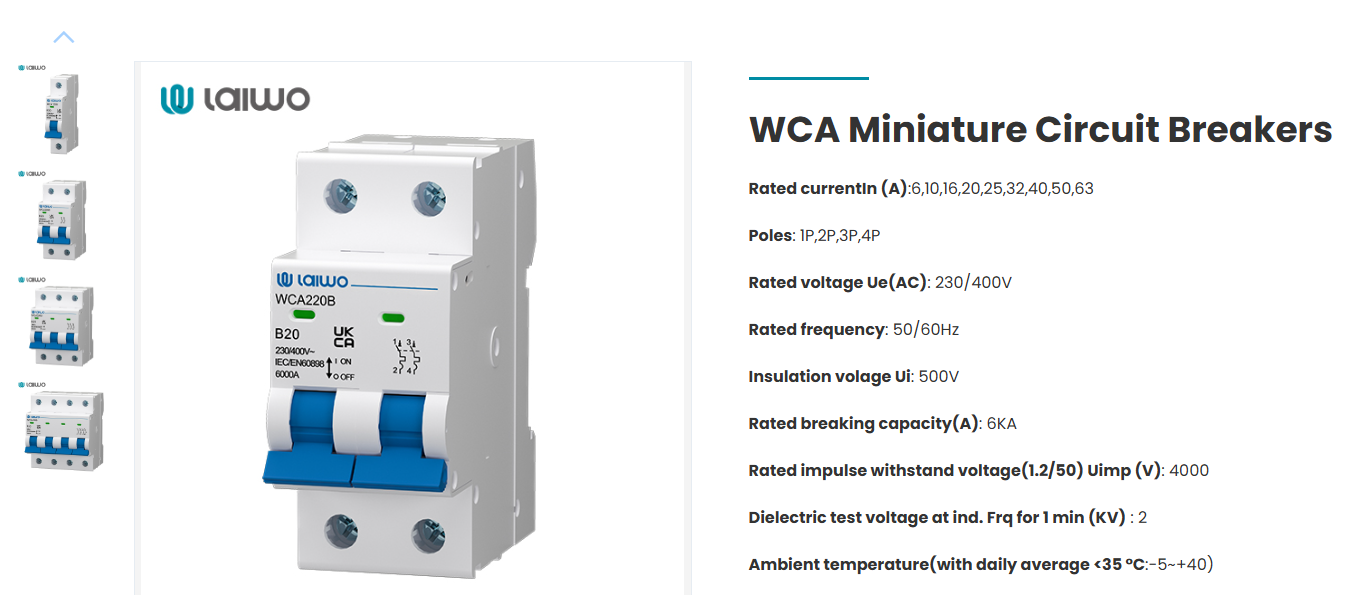Next: DC Circuit Breaker Guide

What is a 20 Amp Circuit Breaker?
Can I replace a 15 amp breaker with a 20 amp?
A 20 amp circuit breaker is a safety device designed to interrupt power flow when current exceeds 20 amps, preventing overheating and damage to wiring. Commonly used in kitchens, workshops, and areas with heavy power requirements, these breakers are designed to handle higher loads than standard 15 amp models.
Thermal-magnetic trip mechanism: Combines heat-sensitive and magnetic triggers for overload and short-circuit protection.
Continuous load capacity: Rated for 80% of maximum current (16 amps) under sustained use, per electrical codes.
Compatibility: Matched with 12-gauge wiring and 20 amp outlets (distinguished by vertical slots).

Learn More: Double 16A MCB Prevent Overloads & Short Circuits
One of the most searched questions—“how many watts on a 20 amp circuit”—boils down to basic electrical principles:
Wattage(W) = Amperage(A) *Voltage (V)
In a 120v circuit, the power of 20 amps is: 20 amps * 120 volts = 2400 watts
In a 220v circuit, the power of 20 amps is: 20 amps * 220 volts = 4400 watts
In a 240v circuit, the power of 20 amps is: 20 amps * 240 volts = 4800 watts
Exceeding these limits risks breakers trips or permanent damage. For example, running a 2,500-watt space heater on a 120V/20A circuit violates the continuous load rule, creating a fire hazard.

| Feature | 15 Amp Breaker | 20 Amp Breaker |
|---|---|---|
| Wire Gauge | 14-gauge | 12-gauge |
| Outlet Type | Standard duplex | 20 amp outlet (with T-slot) |
| Max Continuous Load | 12A (1,440W at 120V) | 16A (1,920W at 120V) |
| Common Applications | Lighting, small electronics | Kitchen appliances, Small appliances |
Overloading Existing Wiring: Using a 20 amp breaker on 14 AWG wire can cause overheating and electrical fires.
Violation of Regulations: DIY electrical work can violate local building codes and result in fines.
Insurance Issues: Improper upgrades might void your home insurance coverage.
Safety Compromise: Incorrect installation creates a dangerous environment with increased risk of electrical shock.
Increased Power Demands
Kitchens, garages, or home offices with added outlets or smart home systems may require dedicated 20A circuits for safer, uninterrupted operation.
High-wattage devices like air fryers (1,500–2,000W), space heaters (1,500W), or EV chargers (3,000W+) often exceed the 1,800W limit of 15A circuits (120V). A 20A breaker supports up to 2,400W, reducing strain.
Frequent Tripping
If a 15A breaker trips despite removing temporary loads, it signals a need for higher capacity—but only if wiring is compatible (e.g., 12-gauge wire for 20A).
Energy Efficiency
Heat pumps or induction stoves draw variable loads; a 20A breaker provides headroom for surges without tripping.
Turn off the main circuit breaker to disconnect power to the entire panel
Wait a few moments to allow any residual energy in the system to dissipate
Remove the panel cover and identify the breaker that needs replacement
Unscrew and remove the faulty breaker
Install the new breaker, ensuring it is properly aligned with the bus connections
Reinstall the panel cover
Restore power by turning on the main circuit breaker
Test the new breaker by turning it off and on to ensure proper operation
Learn More: Circuit Breaker Replacement: Key FAQs on Safety, Steps, and Upgrading Amps
This usually occurs when the circuit is overloaded with too many appliances or devices drawing power simultaneously.
Firstly, identify and unplug any non-essential devices connected to the circuit. Consider redistributing high-wattage appliances to other circuits or upgrading to a higher-capacity circuit breaker if necessary. Additionally, using energy-efficient appliances can help reduce the overall load on the circuit.
Sparks or buzzing sounds emanating from electrical outlets are a serious and immediate warning sign of an overloaded circuit or a dangerous electrical fault.
Stop using it immediately, unplug everything, and don't try to fix it yourself. Call an electrician right away. Also, check other nearby outlets for problems.
Flickering lights can be an indicator of an overloaded circuit or loose wiring connections, which can lead to dangerous electrical problems if not addressed promptly.
Check to ensure that the total wattage of the lights and other devices on the circuit does not exceed the capacity of the 20 Amp breaker. If the issue persists, consult a licensed electrician to inspect for any loose or faulty wiring connections.
Learn More: Overloaded Circuit: Understanding What Can Cause a Overloaded Circuit and Solutions
Electrical codes exist to standardize safety. Key rules for 20 amp circuits include:
80% Rule: Limit continuous loads to 16A (1,920W at 120V).
Proper Wiring: Use 12-gauge copper wire for 20A circuits.
Outlet Compatibility: Never pair a 20 amp outlet with a 15A breaker.
Ignoring these guidelines, such as overloading a circuit with multiple air conditioners, can lead to melted insulation or fire hazards.
Q: "Can a 20 amp breaker handle 1800 watts?"
ANS: A 20 Amp GFCI outlet is used to plug in high-power appliances. It can draw up to 2,400 Watts compared to a 15 Amp outlet that can draw up to 1,800 Watts.
Q: “How large a load can be put on a 20amp breaker?”
ANS: The standard for most household circuits are rated either 15 amps or 20 amps. An important note to remember is that circuit breakers can only handle about 80% of their overall amperage. That means a 15-amp circuit breaker can handle around 12-amps and a 20-amp circuit breaker can handle about 16 amps.
Q: Are 15 amp and 20 amp outlets interchangeable?
ANS: False. 20 amp outlets have a T-shaped neutral slot for compatibility.
Laiwo electrical is a one-stop solution for all your electrical needs including mcb, rcbo ,distribution boxes, surge protectors, earth leakage protection devices and switched sockets. If you have additional questions or need assistance, please feel free to contact the customer service team. Give us a call and we'll have a team of professionals answer your questions!
INQUIRY NOW